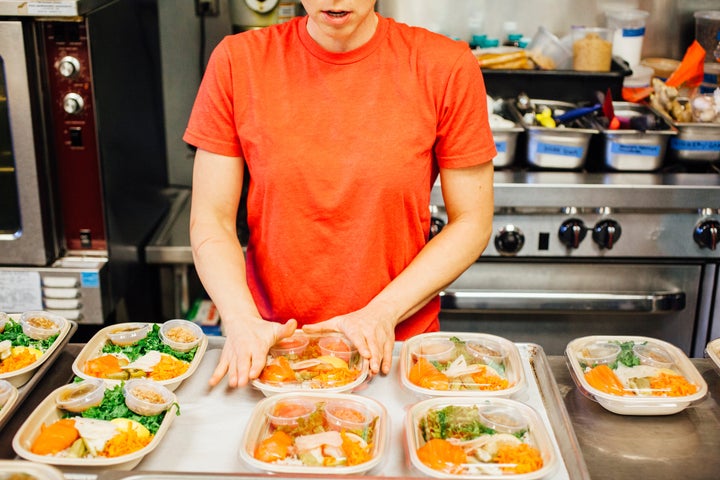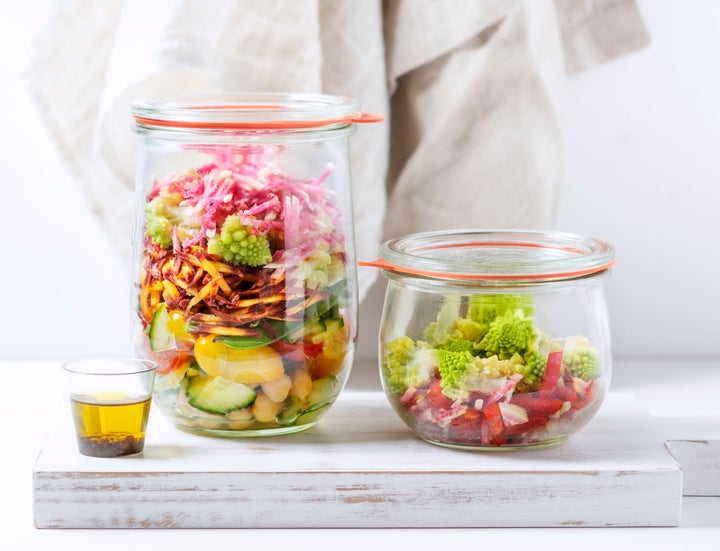How Planning Big-Batch Leftovers Can Dramatically Improve Your Health
Every Sunday, my husband shops for a specific set of organic ingredients, then cooks himself a big-batch, one-skillet meal. The recipe he uses, always gluten-free, includes a protein, a starch, a vegetable and anti-inflammatory spices. He eats it for dinner. Then, after it cools, he packs it away in environmentally friendly glass containers, one for each weekday lunch. He grabs one of these “leftovers” every morning on his way out the door. The following Sunday, he does the same thing all over again, only changing up the recipe.
Sure, it’s kind of a boring way to consume the midday meal. But as a busy physician with very little time between patients, he doesn’t want to rely on takeout for lunch, choosing from a menu that offers an array of temptations. Nor does he like to worry about ingesting processed foods from the hospital cafeteria. With this method, he has his trusty leftovers at hand, ready to heat, eat and provide predictable benefits.
In fact, since he started this food management system, we both see results in him: mood stabilization, improved energy, fewer flare-ups of his chronic inflammatory bowel disease and better sleep.
But is batch-cooking for better health sound nutritional science, or is this simply a placebo effect? Certified clinical nutritionists and functional medicine practitioners say it works on several different levels.
It can help regulate hormones.
“If a [big-batch] meal is made at home from high-quality, fresh, nutrient-dense ingredients, it will tend to balance a number of hormones including leptin, insulin, cortisol, progesterone and estrogen,” said Vikki Petersen, a certified clinical nutritionist and certified functional medicine practitioner. When your hormones are well-regulated, your blood sugar won’t spike. This, in turn, keeps insulin levels stable. Then you’re less likely to have cravings and mood swings.
Plus, Petersen said, there’s a correlation between higher cortisol levels and unbalanced progesterone levels, and maintaining stability is preferable. “Having a meal ‘at the ready’ decreases stress (cortisol hormone) which leads to balanced mood (stable progesterone),” she said.
The words “nutrient-dense” are key to stabilizing hormones, however. In addition to wild or grass-fed proteins, you want non-GMO starches and vegetables filled with fiber and phytochemicals (which are what give plants their color and flavor). In the human body, phytochemicals act as antioxidants, fighting off inflammation, reducing the risk of certain kinds of cancers and advancing overall cardiovascular health. They also, Petersen said, “rid the body of any excess hormones such as estrogen.”
It can promote gut health.
With 30 trillion bacteria living in our intestinal tracts, a lot can go wrong. Most of us are guilty to some extent of adding to our gut’s toxicity with what registered dietitian nutritionist Monica Auslander Moreno calls “known inflammatory” foods: refined grains, trans fats, processed meats, charred foods, added sugars, artificial sweeteners and maltodextrine, a stabilizer in snack products.
Instead, she advises, “Consume foods favorable to your microbiome environment.” These include wild fatty seafood like salmon or trout and prebiotic fiber like oats, artichokes, asparagus, sweet potatoes and squash. She also recommends mixing in fermented foods and Asian mushrooms, which provide a wealth of probiotics that add beneficial bacteria to the gut and help the overall system flourish.
Eating a good variety of gut-friendly foods has a domino effect. The more consistently you consciously consume them, the better your nutrient absorption becomes. As nutritionist Lisa Richards, author of “The Candida Diet,” noted, “A healthy gut will absorb nutrients more efficiently than a gut that is overgrown with bad bacteria and yeast.”
It can fight burnout.
Strategically eating the same dish for lunch or dinner every day provides a modicum of control during times of chaos. Because both ingredients and portion size are predetermined, everyone from those with chronic illnesses to new parents, who suffer from problems like low energy and sleep deprivation, benefit.

Chinese medicine practitioner Dr. Andrea Orvieto advises her patients on how to use nutrition and digestion to reduce adrenal and thyroid burnout. She also helps them alleviate insulin resistance and symptoms from hormone disorders such as not ovulating. “When we live in a world where you can get Chick-fil-A in four different ways, cooking big-batch foods makes it easier,” she said.
While she noted that “even something like spaghetti and meatballs that’s portioned appropriately can have a big positive influence,” she recommends shopping for “deep, dark red” foods like sweet potatoes, beets, dates and goji berries, and employing anti-inflammatory spices such as turmeric, ginger and ginseng.
Portioning batches of home-cooked fare is also a terrific way for those with food allergies, sensitivities and intolerances to regulate mealtime environments. “Even when a restaurant meal ‘sounds good,’ the use of inexpensive oils, farm-raised fish, non-organic produce and more will often lead you to get contaminated with foods you are allergic or sensitive to,” Petersen said.
It can improve your mental health and sleep.
This past year has proven especially difficult for sleeping, and the U.S. population is also suffering from an increase in mood disorders. Batch-cooking can improve all of that.
“A network exists known as the gut-brain axis,” Richards said. “Digestion and the gut’s microbiome can directly impact the nervous system, cognitive function and overall mood.” When you batch-cook nutritious meals ahead of time, you won’t have to lean on takeout or convenient junk foods for lunch.
Petersen agreed that a good mood and a good sleep both depend on solid nutrition. “A healthy, balanced meal will keep stress and sex hormones balanced, leading to a stable mood, good energy, sharp memory, strong libido and happy outlook,” she said. “Decreased stress hormones along with balanced sex hormones, will provide a good framework for deep sleep.” She recommends eating a moderately sized meal no later than three hours before bedtime.
Additionally, while many of us are feeling kitchen burnout, big-batch cooking alleviates the need to make three meals per day. But keep in mind that a little cooking here and there can be good for you. The very acts of chopping and stirring are “cognitive and therapeutic,” Moreno noted. “You become engrossed in the activity. It’s healthy and stimulating for the brain, so there are psychological benefits.”
Finally, cooking this way offers an opportunity to experiment once a week, so it’s creative but not demanding. Moreno advises changing up meals with globally inspired sauces and spices, which are essentially plant-based foods. “Access all of the earth’s vitamins,” she said.

There are some caveats.
As with any system, there are pitfalls. Every practitioner we spoke with recommended keeping freshly prepared food around for no more than 72 hours. For bigger batches, you can vacuum-seal in glass containers and/or freeze them to access when you’re unable to prepare a new batch. That way, they’re still pre-made but last longer. Either way, it’s a good idea to date your leftovers.
The food should cool completely before being placed in the refrigerator, or the ambient foods will heat up to unfavorable temperatures. It’s also crucial to separate food into portions. If that’s not possible, avoid heating and reheating the main portion, which could lead to the development of bacteria.
Finally, vary your recipes and rotate ingredients. If it gets too dull, you’re likely to resume old habits. That said, because it’s not a diet but a lifestyle, you can take breaks without feeling guilty. We go on vacation and have weekend “off” days. Then, come Sunday, my husband will resume his schedule — and often make enough to feed me for the week, too. Along with him teaching himself how to cook, that might be the biggest benefit of all.







